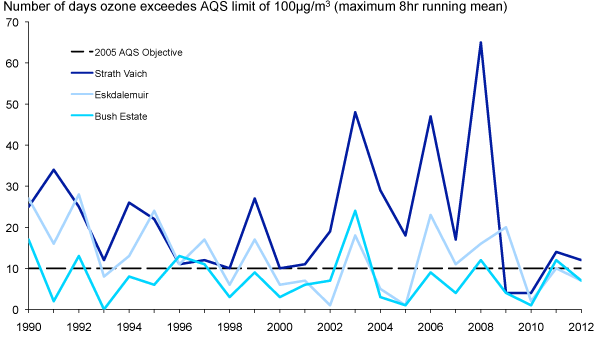Key Scottish Environment Statistics 2013
This publication aims to provide an easily accessible reference document which offers information on a wide range of environmental topics. It covers key datasets on the state of the environment in Scotland, with an emphasis on the trends over time wherever possible. The data are supplemented by text providing brief background information on environmental impacts, relevant legislation and performance against national and international targets.
This document is part of a collection
Ground Level Ozone Concentrations1: 1990-2012

Ozone in the stratosphere forms a layer that protects the Earth against harmful ultra-violet radiation, but tropospheric (ground level) ozone is a damaging oxidant. Exposure to high ozone concentrations can cause respiratory damage, and affects vegetation by damaging leaves and reducing yields.
Ozone is formed by a slow, complicated series of reactions from other pollutants that may be blown over from Europe. The most important man-made precursors are nitrogen oxides and volatile organic compounds produced by road transport, industrial processes and solvent use. Ozone concentrations tend to be lower in urban areas where it is converted to nitrogen dioxide by reacting with nitrogen oxides.
The Air Quality Strategy5 objective for ground level ozone concentration (to be met by 2005) states that the maximum daily concentration (measured as an 8-hour running mean) of 100µg/m3 should not be exceeded more than 10 days per year. In 2012, this objective was met at 8 of the 9 sites.10 The site that failed was Strath Vaich. Strath Vaich regularly fails to meet the AQS objective, most recently failing in the periods 2005-08 and 2011-12.
Source: Scottish Air Quality Database / Metadata
Contact
Email: Callum Neil
There is a problem
Thanks for your feedback